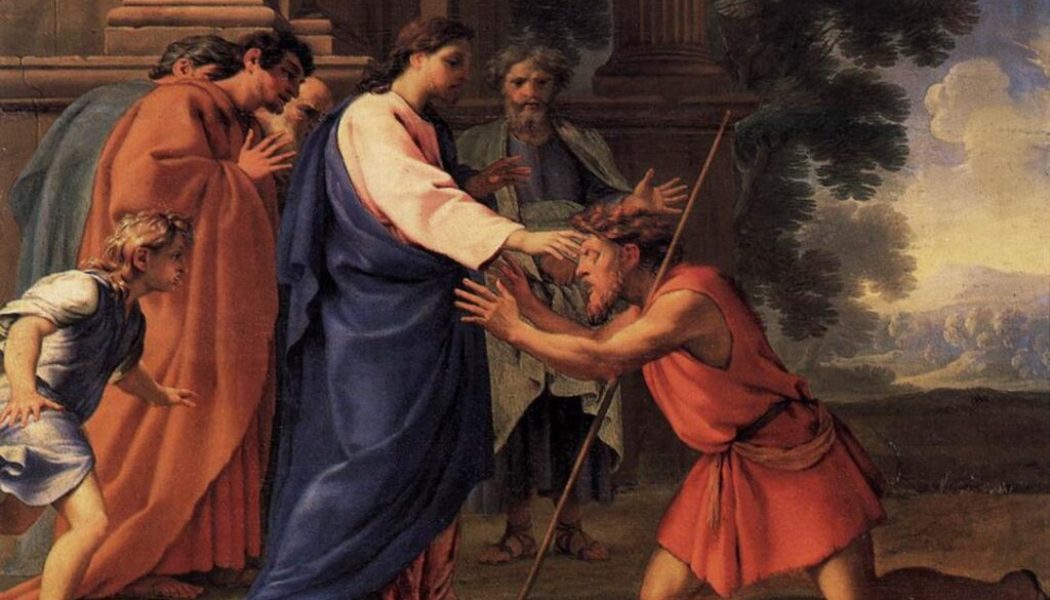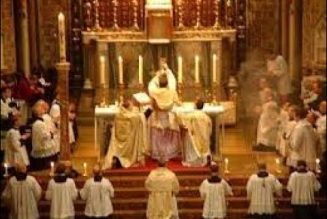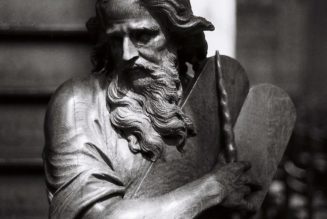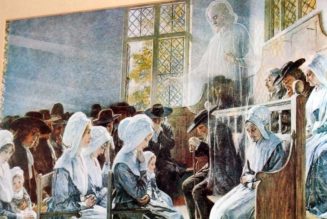Objections to the practice of Eucharistic adoration have come to the fore once more in light of the concerted efforts for a Eucharistic revival in the United States. Recently, Eucharistic adoration has been described as passive in nature, yet I would argue that Eucharistic adoration is a form of devotion and piety that can assist in achieving the “aim to be considered above all else” set forth by the Second Vatican Council regarding the sacred liturgy: active participation.
Adoration begins within the celebration of Mass, and Eucharistic devotion outside of Mass is always directed back towards the font of the sacred liturgy. Recent popes, including this past August, Pope Francis (see News & Views, page 1) have offered a consistent voice in favor of the renewal and promotion of the practice of varying forms of Eucharistic devotion beyond the sacred liturgy. Finally, the saints give witness to the way in which Eucharistic devotion compels the faithful to be directed towards the active mission of charity.
Adoration and Liturgy
Adoration of the Most Blessed Sacrament and the celebration of the most sacred liturgy are inseparable. The Sacred Congregation for the Sacraments and Divine Worship emphasizes this unity: “for the presence of Christ, who is adored by the faithful in the Sacrament, derives from the sacrifice and is directed towards sacramental and spiritual Communion.” The Benedictine abbot of Mount Angel Abbey, Jeremy Driscoll, summarizes the relationship between love and adoration: “It is not possible to love Christ without adoring him.” The current Eucharistic Revival in the Church in the United States has directly contributed to the need for Eucharistic adoration and processions as an important part of its mission which is “To renew the Church by enkindling a living relationship with the Lord Jesus Christ in the Holy Eucharist.” There is nothing passive in nature about Eucharistic adoration.
Adoration begins within the celebration of Mass, and Eucharistic devotion outside of Mass is always directed back towards the font of the sacred liturgy.
The point is often raised that the practice of Eucharistic adoration is relatively new in the life of the Church. Often, critics write of Eucharistic devotion as a misunderstood form of medieval piety or a representation of a so-called pre-Vatican II theology from which we have moved on. After all, they argue, the end for which the Eucharist has been given to us by Our Lord is Holy Communion. In other words, critics of Eucharistic adoration contend that the Eucharist has not been made for us to look at, but to eat. Historically, it is the case that the practice of reservation of the Blessed Sacrament was for the sake of distributing Communion to the faithful who were unable to participate in the sacred liturgy. Yet, does this purpose of reservation of the Blessed Sacrament really preclude the development and practice of Eucharistic adoration?
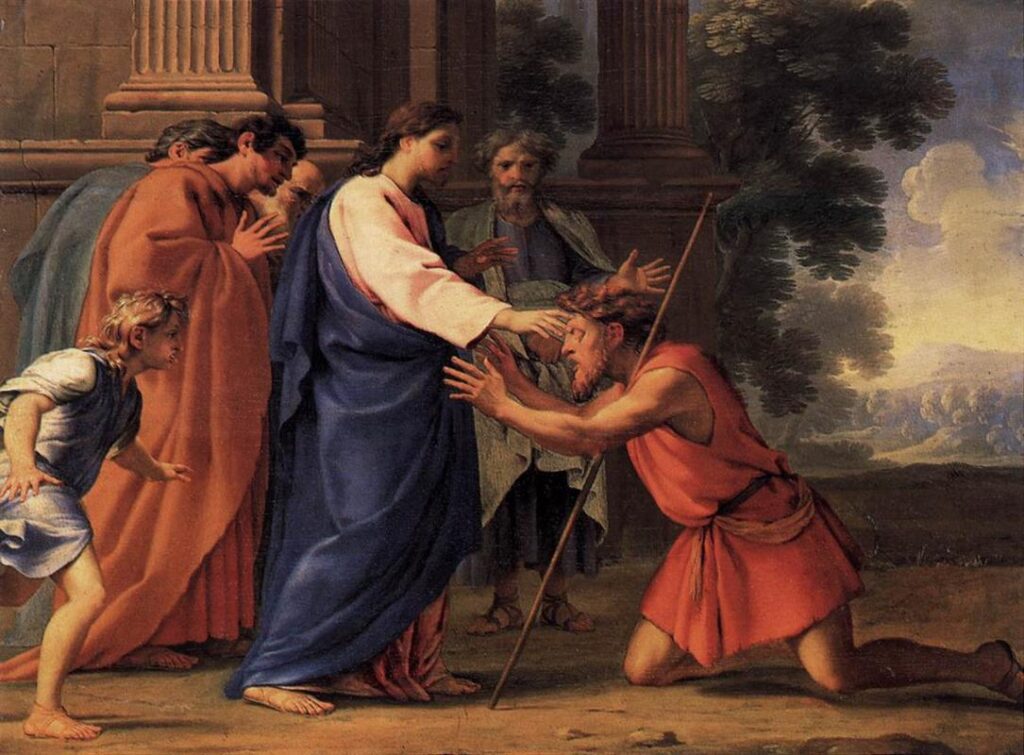
One of the most robust responses to this question has been given by Pope Benedict XVI in Sacramentum Caritatis (SCar): “In the Eucharist, the Son of God comes to meet us and desires to become one with us; eucharistic adoration is simply the natural consequence of the eucharistic celebration, which is itself the Church’s supreme act of adoration. Receiving the Eucharist means adoring him whom we receive. Only in this way do we become one with him, and are given, as it were, a foretaste of the beauty of the heavenly liturgy. The act of adoration outside Mass prolongs and intensifies all that takes place during the liturgical celebration itself” (66, emphasis added).
Adoration begins within the sacred liturgy. Abbot Driscoll notes that this form of adoration is directed primarily towards God the Father through Jesus Christ in the Holy Spirit, but he notes that there are distinct moments in the liturgy “where Christ himself is adored in the very elements of the Sacrament.” Properly understood, Eucharistic adoration becomes an extended form of thanksgiving that in the words of Pope Benedict “prolongs and intensifies” all that has unfolded in the celebration of the Mass.
It is not possible to love Christ without adoring him.
–Rev. Jeremy Driscoll, O.S.B.
In the Gospels, Christ healed ten lepers, but only one (a Samaritan) returned to thank him. Our Lord looked upon him and asked these questions: “Were not ten cleansed? Where are the nine? Was no one found to return and give praise to God except this foreigner?” And he said to him, “Rise and go your way; your faith has made you well” (Luke 17:17-19).
Eucharistic adoration can be likened to this act of the Samaritan leper. We return to the Lord in the Blessed Sacrament either in the tabernacle or exposed in the monstrance as a concrete act of thanksgiving for the continual healing and renewal that we experience from the celebration of the sacrament of charity.
While Eucharistic adoration, as we know it in its present form, may not have developed until the 11th or 12th centuries, adoration and thanksgiving began with recognition of Jesus Christ during his public ministry. In other words, to quote Abbot Driscoll once again: “It is not possible to love Christ without adoring him.” In the period after the Second Vatican Council, magisterial teaching has consistently laid the foundation for the active promotion of Eucharistic adoration as a normative practice for the Latin Church.
In the period after the Second Vatican Council, magisterial teaching has consistently laid the foundation for the active promotion of Eucharistic adoration as a normative practice for the Latin Church.
Papal Eucharistic Revival
Before the present Eucharistic Revival in the United States, we can hear the hope for an explicit revival of Eucharistic devotion for the universal Church in the teaching of Pope St. Paul VI. In his encyclical, Mysterium Fidei (MF), St. Paul VI commends the practice of making visits to the Blessed Sacrament during the course of the day as a “proof of gratitude” and a “pledge of love” (MF, 66).
At the beginning of the encyclical, Pope Paul VI expresses the hope that the implementation of the “restoration of the sacred liturgy” will lead to a flourishing of Eucharistic devotion, which makes ironic the above mentioned claim that these forms of Eucharistic piety are pre-Vatican II. In fact, Pope Paul VI explicitly contends that the Second Vatican Council has prepared the way for a “new wave of Eucharistic devotion” that “will sweep over the Church” (MF, 13).
Pope Paul VI exhorts the bishops of the universal Church with great clarity to preserve devotion to the Holy Eucharist for the faithful which he contends should be the “focal point and goal of all forms of devotion” (MF, 64). Unfortunately, it seems the exact opposite took place in the life the Church. Forty-hour devotions, the practice of perpetual adoration in religious communities, the availability of exposition and benediction, Eucharistic processions, etc. have declined. It somehow became the norm that the focus on the reformed liturgy precluded the practice of Eucharistic devotion and any form of popular piety. Pope Paul VI beautifully maintains the view that there is “nothing more efficacious for progress along the paths of holiness” than Eucharistic devotion (MF, 67), yet we have separated the sacred liturgy from Eucharistic devotion to our own spiritual peril within the Church.
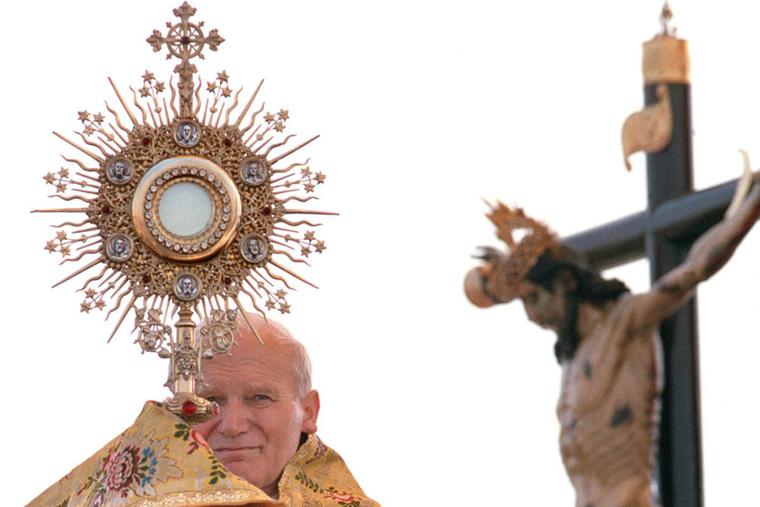
After Pope St. Pius X (d.1914), Pope St. John Paul II may be truly one of the most “Eucharistic popes” for his repeated insistence upon the need for devotion to the Blessed Sacrament outside of Mass and other magisterial writings focused on the celebration of the liturgy and Eucharistic doctrine. In his final encyclical, Ecclesia de Eucharistia (EE), St. John Paul II notes the tension within the practice of Eucharistic devotion in the Church. On the one hand, Eucharistic adoration has become “an important daily practice and becomes an inexhaustible source of holiness” (EE, 10). On the other hand, this bright light is contrasted with “shadows” within the Church whereby the practice of Eucharistic adoration is almost non-existent in some places within the Church.
In concert with Pope Paul VI, Pope John Paul II also emphasizes the promotion of the varying forms of Eucharistic devotion as “proofs of that authentic renewal which the [Second Vatican] council set itself as an aim and of which they are the central point” (Dominicae Cenae (DC), 3). In addition to the varying forms of Eucharistic piety mentioned above, Pope John Paul II also highlights Eucharistic congresses and he highlights the importance of the Solemnity of the Body and Blood of Christ (Corpus Christi). Pope John Paul II also affirms the inseparable link between Eucharistic adoration and the sacrifice of the Mass, and he exhorts all pastors to promote Eucharistic adoration and devotion by their personal witness (see EE, 25). He makes the need for Eucharistic adoration explicit: “The Church and the world have a great need of eucharistic worship. Jesus waits for us in this sacrament of love. Let us be generous with our time in going to meet Him in adoration and in contemplation that is full of faith and ready to make reparation for the great faults and crimes of the world. May our adoration never cease” (DC, 3). St. Paul VI and St. John Paul II make clear the need for Eucharistic devotion in the life of the Church as a fruit of the liturgical renewal intended by the Second Vatican Council.
The act of adoration outside Mass prolongs and intensifies all that takes place during the liturgical celebration itself.
–Pope Benedict XVI
Pope Benedict XVI’s writings also recognize the growing appreciation of, and increase in, the practice of Eucharistic devotion in parts of the Church as part of the “liturgical renewal desired by the Second Vatican Council,” but he acknowledges that during the early part of the reform following the Council “the inherent relationship between Mass and adoration of the Blessed Sacrament was not always perceived with sufficient clarity” (SCar, 66). In both his pre-papal writings and papal writings, Joseph Ratzinger/Benedict XVI argues for the inseparable unity between the celebration of the liturgy and Eucharistic adoration and the social mission that flows out of authentic Eucharistic devotion.
Joseph Ratzinger argues against the distinction between the so-called “thing-centered” view of the Eucharist in the Patristic period and the personalistic view of the Eucharist in the post-medieval period. The development of Eucharistic adoration was not a misguided practice that arose from the “thing-centered” view. The practice of Eucharistic adoration was an important development from both the Franciscans and the Dominicans in Ratzinger’s view because this practice was “a new dimension of the reality of Christianity” that was opened up “through the experience of the saints, supported and illuminated by the reflection of theologians.” The Holy Eucharist is the sacramental presence of Jesus Christ. The abiding presence of Christ reserved in the tabernacle or exposed in the monstrance on the altar for adoration is a fulfillment of what has been celebrated in the sacred liturgy.
Eucharistic adoration has an inherent link to mission, evangelization, and charity.
Building upon his own theological insights and reflections and the teaching of his predecessors, Pope Benedict XVI calls for the spread of the practice of Eucharistic devotion. He even explicitly calls for the promotion of chapels or oratories of perpetual Eucharistic adoration particularly in “densely populated cities” (SCar, 67). He also maintains the view that in new churches where Blessed Sacrament chapels cannot be located near the sanctuary, the tabernacle should located in the sanctuary in a “sufficiently elevated place, at the center of the apse area, or in another place where it will be equally conspicuous” (SCar 69).
Finally, Pope Francis exhorts all members of the Church to renew the practice of Eucharistic devotion. Recently during his trip to World Youth Day in Lisbon, he said, “Only in adoration, only in the presence of the Lord, do we truly rediscover our taste and passion for evangelization. Oddly enough, we have lost the prayer of adoration; and everyone, priests, bishops, consecrated men and women, need to recover it, this ability to be quiet in the Lord’s presence.” Eucharistic adoration has an inherent link to mission, evangelization, and charity. In varying contexts, Pope Francis urges the faithful to “waste time” before the Lord in Eucharistic adoration because it is a source of grace and fuel for our life of charity. Recent popes have explicitly and consistently supported the venerable practice of Eucharistic adoration as a means of renewal of faith and continuation of what has begun in the celebration of the sacred liturgy.
Adoration and Mission
The inherent connection between the celebration of the sacred liturgy and the practice of Eucharistic devotion has not been made explicit in catechesis and theology within the Church, yet papal teaching and the experience of members of the Church, particularly the saints, make this connection with great clarity. The regular practice of Eucharistic devotion in varying forms has been a vital source of charity in the lives of the saints. St. Damien of Molokai, St. Katherine Drexel, St. Teresa of Calcutta, Blessed Pier Giorgio Frassati, St. Vincent de Paul, and countless members of the litany of saints made frequent visits to the Blessed Sacrament for short and even extended periods of time. Adoration was never a passive practice for any of these saints. The social mission of the Church would never have been fruitful without their Eucharistic devotion. In the words of St. Teresa of Calcutta, they would have been “too poor to serve the poor.”
Adoration was never a passive practice for any of these saints.
The gift of the abiding Presence of Christ in the Holy Eucharist flows out of the liturgy, and adoration of the Most Blessed Sacrament can strengthen one’s preparation in the Mass. Both individual and communal forms of Eucharistic devotion provide short or even extended periods of silence, which is essential for fruitful active participation in the sacred liturgy. Further, worship is not limited to what takes place explicitly within the Mass.
The new form of worship given to us by Jesus Christ includes the transformation of the faithful person. Consequently, Eucharistic adoration precludes any form of passivity when it comes to charity. Benedict XVI has made it clear that the Holy Eucharist is “intrinsically fragmented” without an explicit expression of charity for one’s neighbor (see Deus Caritas Est, 14). If people are passive or indifferent towards their neighbor despite the practice of Eucharistic devotion, then the conclusion to be drawn is not that Eucharistic adoration is inherently passive. These people are not fully worshiping Christ in spirit and truth because of the inseparable link between the Eucharist and mission.
Adoration precedes Holy Communion and brings communion to its logical fulfilment. Communion unifies an individual to both God and neighbor. We should encourage the practice of all forms of Eucharistic devotion during this period of Eucharistic revival and we need to do a better job in our catechesis, preaching, and teaching about the unity between the celebration of the Mass, Eucharistic devotion, and social action. In other words, we need to be clearer about the inherent nature of the Eucharist as a “sacrament of charity.” O Come, let us adore Him!
Roland Millare serves as vice president for curriculum and program director of Clergy Initiatives (continuing education and formation programs for priests and deacons) for the St. John Paul II Foundation, Houston, TX, and as an adjunct professor of theology at the University of St. Thomas School of Theology at St. Mary’s Seminary, Houston, TX, the University of Dallas, and the Diocese of Fort Worth. He earned a doctorate in sacred theology (STD) at the Liturgical Institute/University of St. Mary of the Lake, Mundelein, IL, and is the author of the book A Living Sacrifice: Liturgy and Eschatology in Joseph Ratzinger (Emmaus Academic).
